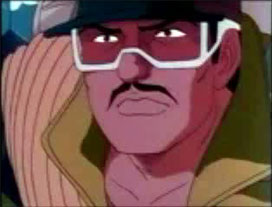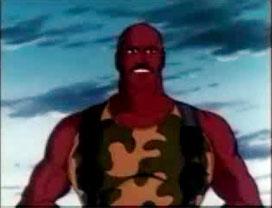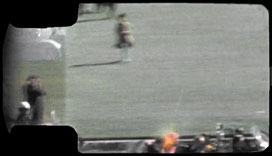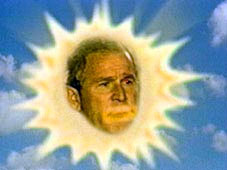Excerpt from the book Sign Wars: The Culture Jammers Strike Back
8 Sep 2005
Fensler, Lussenhop, Sanborn and Boyce: witty jams right in the face of the Terror
Death (like control) needs time for that it kills to grow in.—William Burroughs
Since the tragic, sudden and unprecedented attacks on the World Trade Center and the Pentagon in September 2001, a new type of aesthetic can be said to have emerged in culture-jammer circles. Much of this work stems from the art underground of the city of Chicago, and particularly from the artists Doug Lussenhop and Eric Fensler.
This work is filled with camp burlesque and satirical humour, and is bitterly critical of authority and the various forms it takes, particularly the uniformed kind. It aims squarely at the hypocrisy of the current stupid-white-men-in-charge whose complete disregard for the views of other countries, let alone fellow citizens has sparked a worldwide counter-revolution fought out on the battle-zone of the media-scape.
[this] newer Chicago work [evokes] the banality of everyday life which conservative culture seeks to foster and develop in society, and out of which its own values grow.
This new work is not in-your-face overtly political in its delivery as say, Phil Patiris’s Iraq Campaign whose message is very much built around a solid political critique of war and media. Rather the newer Chicago work seeks to evoke something of the banality of everyday life which conservative culture seeks to foster and develop in society, and out of which its own values grow. Like mushrooms, right-wing values prosper in the dark, where people are expected to remain. This is the blithe ‘the-world-is-there-to-be-managed’ banality that motivational speakers exude while giving a pep talk to trucking employees. It is the banality of fixing a broken printer in an office building, and the banality of being told how to avoid danger by a cartoon action figure. These examples describe several of the low budget culture jammer films of Doug Lussenhop and Eric Fensler.
Doug Lussenhop and Eric Fensler
 Eric Fensler’s most famous recent culture jammer work is the clever re-editing and post-voicing of G.I. Joe Public Service Announcements or PSAs. As the name suggests, PSAs normally work in the US as ways to inform the public on issues of public safety and what to do in an emergency. The original G.I. Joe public service announcements were cartoons using the popular boys’ action figure (known as ‘Action Man’ in the UK and Australia) warning about the dangers which might befall children during course of the day. These include playing rough with other children with a football (nosebleed), setting fire to the kitchen by not knowing how to use a stove, playing on thin sheets of river ice, burning yourself on the campfire while camping, and so on.
Eric Fensler’s most famous recent culture jammer work is the clever re-editing and post-voicing of G.I. Joe Public Service Announcements or PSAs. As the name suggests, PSAs normally work in the US as ways to inform the public on issues of public safety and what to do in an emergency. The original G.I. Joe public service announcements were cartoons using the popular boys’ action figure (known as ‘Action Man’ in the UK and Australia) warning about the dangers which might befall children during course of the day. These include playing rough with other children with a football (nosebleed), setting fire to the kitchen by not knowing how to use a stove, playing on thin sheets of river ice, burning yourself on the campfire while camping, and so on.
The original scenarios aired on television are short tableaux about common dangers facing children with G.I. Joe, or one of his sidekicks, stepping in just in time to correct the problem. The original spots were also ads for a toy riding on the back of supposed concern for ‘public safety’. Fensler adds his own new voice-overs to these scenes and makes them slightly menacing encounters between men and children, where kids faced with a dangerous situation have looming macho authority figures explain ways of solving the situation. These figures often lurch into the frame or hover nearby and often speak complete nonsense or berate the children for their stupidity, or panic worse than anyone else at the disaster unfolding before them. The children react in kind by confronting the strange adults with street language of their own.
Generational warfare between supposedly confident, safety-aware adults and not-as-dumb-as-they-look children is the central battleground in the G.I. Joe PSAs. This is a critique in many ways of the kind of moral currency being foistered upon the world by the likes of George Bush, Donald Rumsfeld, and their ‘old-world’ values. This top-down worldview sees the population essentially as children who need the absurdity of oil wars explained to them terms of a ‘Middle-East’ to make them feel secure – all delivered in the patronising fatherly tone normally reserved for warning children what happens if you are not careful with a box of matches.
G.I. Joe is a powerful shorthand signifier of the broader US military entertainment complex. The latter is that unique nexus between media, popular culture, and official foreign policy which is all too willing to have us believe that the interests of the US public lie in the actions of the military in Iraq and Afghanistan, no matter how extreme such actions seem to get with each passing week.
The hapless G.I. Joe (indeed no stranger to the culture jammer’s deft hand since the Barbie Liberation Organization altered his voice-box), has his central authority as a military role model discredited. Progressive gender politics is driving the gestures to ‘out’ him as something less than a ‘macho man’ and/or a credible role model for kids that this stereotype represents. In the early 70s when I was but a small boy, I too liked to play with my Action Man but, of course, years later I realised that much of my accompanying taste for doll-mediated combat games was fuelled by fantasies which came with the doll free of charge, and are nothing if not compatible with the requirements of an authoritarian government. It does not have to be a conspiracy for it to work like one.
By playfully jibing the moralistic patriarchy propping up the G.I. Joe mythos, Fensler is indirectly attacking the parental myth that adult=authority=safety. This is the true understated power behind Eric Fensler’s work. It is willing to call the bluff of the dominant social order’s insistence that nothing else can or should be a ‘moral guardian’ for the population. G.I. Joe, thus, as symbolic guardian / soldier / authority figure, is exposed, in Fensler’s jams, as a slightly creepy, pervy weirdo. The cartoons are hilariously funny and in some Internet reports, entire rooms of people are claimed to have burst into peals of spontaneous laughter during their screening.
GI Joe Public Service Announcements – culture-jammed solider toy ads
 The voices of the G.I. Joe characters are often aggressive, threatening, or generally uncanny. Two boys on BMX bikes are about to face a deadly electrical wire cut from its pole on an open road. They discuss what they will do with it:
The voices of the G.I. Joe characters are often aggressive, threatening, or generally uncanny. Two boys on BMX bikes are about to face a deadly electrical wire cut from its pole on an open road. They discuss what they will do with it:
Boy 1: Oh man, check out that thing, man?
Boy 2: What do you want to do with it?
Boy 1: Lets launch over it!
A black man in combat gear arrives in a jeep with a long pole-like implement
Black Man: Body Massage machine, (sings) Who wants a body massage?
Boy 1: What did he just say to us?
 In scenes like this the danger faced by the boys is quickly eclipsed by the more vague but no less tormenting threat from the adults appearing in their midst. The adults are the people these kids have to defend themselves from by being aware, and more aware than the adults can be allowed to know: these kids keep the adults in their midst unaware of their private subculture, its language, its gestures and its behaviours. Popular culture references to drum and bass music and techno underground culture also form the basis of these reworked PSAs, with characters breaking into dub-type rapping, the children near them joining in instantly.
In scenes like this the danger faced by the boys is quickly eclipsed by the more vague but no less tormenting threat from the adults appearing in their midst. The adults are the people these kids have to defend themselves from by being aware, and more aware than the adults can be allowed to know: these kids keep the adults in their midst unaware of their private subculture, its language, its gestures and its behaviours. Popular culture references to drum and bass music and techno underground culture also form the basis of these reworked PSAs, with characters breaking into dub-type rapping, the children near them joining in instantly.
Keith Sanborn
 New York-based Keith Sanborn’s film ‘The Artwork in the Age of its Mechanical Reproducibility’ by Walter Benjamin as told to Keith Sanborn is a video artwork released in 1996. It is made up entirely of frame grabs of FBI warning signs that appear at the beginning of rented and bought videos and DVDs. The warnings are cut in time to some 1950s’ style rumba music, of the sort associated with early 1960s sitcoms like I Dream of Jeannie. Eventually rather than cutting from one warning against copying to another, the warnings start to move slowly, almost dance around the screen. Bubbles float around with them. Sanborn is making these signs literally ‘float free’ from their intended purpose.
New York-based Keith Sanborn’s film ‘The Artwork in the Age of its Mechanical Reproducibility’ by Walter Benjamin as told to Keith Sanborn is a video artwork released in 1996. It is made up entirely of frame grabs of FBI warning signs that appear at the beginning of rented and bought videos and DVDs. The warnings are cut in time to some 1950s’ style rumba music, of the sort associated with early 1960s sitcoms like I Dream of Jeannie. Eventually rather than cutting from one warning against copying to another, the warnings start to move slowly, almost dance around the screen. Bubbles float around with them. Sanborn is making these signs literally ‘float free’ from their intended purpose.
The FBI warnings, now the actual subject matter of a movie in their own right have been transformed. In becoming subjects of the viewer’s gaze rather than stand-ins for actual authority, they can be seen to have lost their power. This symbolic robbing of power of powerful signs was the basis of the controversy surrounding the 1960s’ paintings of Jasper Johns, who famously painted as fine art, iconic images like the US flag and archery targets.
By turning signs into things to be examined, the original ‘authority payload’ of a sign is thus ‘deflated’. Sanborn is being playful with FBI warning signs and inviting his audience to ‘take with a pinch of salt’ the warnings themselves. It is a nod and a wink to those who embrace the Situationist notion that ‘plagiarism is necessary, progress implies it’.
So why does Sanborn seek to playfully undermine an FBI copyright warning by making it dance the samba? He does so in order to invite the viewer to contemplate the idea that there is no such thing as ‘essential’ power, other than that which we in society agree to consensually. Take away the warning sign’s assumed inherent embodiment of authority to the viewer, and symbolically the entire authority system is thwarted and destabilised. Power and authority are thus inherently tentative, provisional and fragile, and must be agreed to by all in order to exist in a democracy.
Copyright warnings are, from the point of view of culture jamming, as worthless as the paper they are printed on, or the pixels which make them up on the screen. They are just bits of videotape, Sanborn is saying: let’s have some fun with these meaningless, obsolete, and impotent sign systems and show them up for what they are. This call to action frames the bigger issue: who has the right and who does not have the right to make use of ideas in general. Who is authorised and who has power?
Keith Sanborn ruminates on the famous 1963 Zapruder footage of JFK’s assassination in Dallas, Texas.
 Sanborn’s rumination on the famous Abraham Zapruder standard 8mm footage of John F Kennedy’s assassination ‘The Zapruder Footage: An Investigation of Consensual Hallucination’ (1999), plays and replays the Zapruder footage. The famous motorcade approaches, the limo with Kennedy waving goes behind the sign, it emerges from the sign with Kennedy clutching his neck. The car passes us, Kennedy leans forward and is shot in the head, blood mist clearly showing the fatal shot. Sanborn loops the footage and it is as if by repeating the sequence enough times, some kind of truth about the event it depicts can be divined. Alas, as Sanborn discusses in his interview with Peggy Nelson in Craig Baldwin’s online fanzine Otherzine, no number of viewings of Abraham Zapruder’s home movie does anything to demystify the killing it records. The more one watches, the less one knows.
Sanborn’s rumination on the famous Abraham Zapruder standard 8mm footage of John F Kennedy’s assassination ‘The Zapruder Footage: An Investigation of Consensual Hallucination’ (1999), plays and replays the Zapruder footage. The famous motorcade approaches, the limo with Kennedy waving goes behind the sign, it emerges from the sign with Kennedy clutching his neck. The car passes us, Kennedy leans forward and is shot in the head, blood mist clearly showing the fatal shot. Sanborn loops the footage and it is as if by repeating the sequence enough times, some kind of truth about the event it depicts can be divined. Alas, as Sanborn discusses in his interview with Peggy Nelson in Craig Baldwin’s online fanzine Otherzine, no number of viewings of Abraham Zapruder’s home movie does anything to demystify the killing it records. The more one watches, the less one knows.
There are copies of some of those frames in a book called 26 Seconds in Dallas. If you ever find it you should buy it, but it’s really hard to find. It’s a close reading of the Zapruder footage by this guy who was a philosophy professor at Haverford at the time. I can’t remember his name, but anyway, subsequent to that, he became a private detective in San Francisco, and he has a book out about that too! He says that most crimes have a kind of pattern where the details hang together and start to narrow. They start to solidify and they start to form a pattern. But, he says, the Kennedy assassination does not. The longer people go on about it the more diffuse it gets.
—Keith Sanborn interviewed in OTHERZINE by Peggy Nelson. ‘X Marks the Spot: Hunting for Buried Treasure with Keith Sanborn,’ Spring, 2002.
Images can thus reinforce the obfuscation that events leave behind them like so much cultural turbulence. This is in my view, also tragically true of the now iconic multi-angle video footage of the Twin Towers disaster of September 2001. No matter how many times you watch those planes collide with those buildings, and then watch the buildings collapse, the answers to fundamental questions that these images raise in the viewer dissolve along with the planes and buildings themselves: what exactly motivated this event? Why these targets exactly? Why this date, this time in history?
Sanborn culture jams Zapruder by obsessively, forensically rewinding, replaying the hauntingly slow parade (another Oliver Stone type question: just why did those cars slow down at just that point in the motorcade?). Watching his reworking of the footage becomes strangely peaceful and meditative. As soon as that huge black open limo turns the corner at the beginning of the shot the knowledge of what is about to happen frames the whole event of the filmed sequence as a kind of weird death-ritual; a parricidal ceremony, as entrancing-yet-horrifying as any recorded ritual slaughter of an animal by remote tribes-people, such as that controversially filmed for Apocalypse Now.
In the later part of the work, by overlaying blocks of digital squares and rectangles over the footage, it is as if Sanborn has decided to work with the footage, play with it, now resigned to its utter impenetrability. As evidence, home movie footage of momentous events collapses under scrutiny. It is as if the footage cannot deal with the expectations the viewer places upon it and says, through its very banal matter-of-factness: ‘I give up! All I did was record the event!’
Bryan Boyce
 San Francisco-based Bryan Boyce’s ‘State of the Union video, 2001’, is a two minute digitally reworked CNN image of George W. Bush in the place of the laughing baby sun of the BBC children’s show ‘The Teletubbies’. As Bush, the sun king / baby king emerges over the horizon, the bunny rabbits of Telletubbyland frolic below him. Something is not right in Teletubbyland. As in a nightmare, the place we’re in seems familiar enough, but other media and other geographic features have imposed themselves upon the normally kid-safe wonderland usually inhabited by the now-strangely-absent cute TV-enhanced cuddly aliens. Oil-well towers dot the landscape. One by the one the furry rabbits which normally frolic happily in this storybook world suddenly explode violently as Bush-as-the-sun fires laser beams from his mouth at them. Eventually one rabbit is left. A laser beam is fired and the land fills with oil, until this last rabbit is itself blown up by the deadly Bush-sun.
San Francisco-based Bryan Boyce’s ‘State of the Union video, 2001’, is a two minute digitally reworked CNN image of George W. Bush in the place of the laughing baby sun of the BBC children’s show ‘The Teletubbies’. As Bush, the sun king / baby king emerges over the horizon, the bunny rabbits of Telletubbyland frolic below him. Something is not right in Teletubbyland. As in a nightmare, the place we’re in seems familiar enough, but other media and other geographic features have imposed themselves upon the normally kid-safe wonderland usually inhabited by the now-strangely-absent cute TV-enhanced cuddly aliens. Oil-well towers dot the landscape. One by the one the furry rabbits which normally frolic happily in this storybook world suddenly explode violently as Bush-as-the-sun fires laser beams from his mouth at them. Eventually one rabbit is left. A laser beam is fired and the land fills with oil, until this last rabbit is itself blown up by the deadly Bush-sun.
The association of George W. Bush with infantilism rings true with those who see the man and his politics as being so simplistic as to be akin to kindergarten level language and ideas. ‘State of the Union’ offers up the world as the neo-cons might well themselves see it: one big oil well, with populations like children that need to be taught what’s good for them, or else.
David Cox, San Francisco. dcox.customer.netspace.net.au/dcox.html◊
Published by Pluto Press Australia (due for release 2006).
Official web site for the book: www.plutoaustralia.com/p1/default.asp?pageId=23